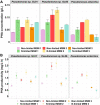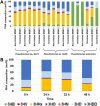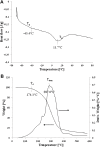Effect of short- and medium-chain fatty acid mixture on polyhydroxyalkanoate production by Pseudomonas strains grown under different culture conditions
- PMID: 35957637
- PMCID: PMC9358023
- DOI: 10.3389/fbioe.2022.951583
Effect of short- and medium-chain fatty acid mixture on polyhydroxyalkanoate production by Pseudomonas strains grown under different culture conditions
Abstract
Short- and medium-chain fatty acids (SMCFAs) derived from the acidogenic anaerobic mixed culture fermentation of acid whey obtained from a crude cheese production line and their synthetic mixture that simulates a real SMCFA-rich stream were evaluated for polyhydroxyalkanoate (PHA) production. Three individual Pseudomonas sp. strains showed different capabilities of growing and producing PHAs in the presence of a synthetic mixture of SMCFAs. Pseudomonas sp. GL06 exhibited the highest SMCFA tolerance and produced PHAs with the highest productivity (2.7 mg/L h). Based on these observations, this strain was selected for further investigations on PHA production in a fed-batch bioreactor with a SMCFA-rich stream extracted from the effluent. The results showed that PHA productivity reached up to 4.5 mg/L h at 24 h of fermentation together with the ammonium exhaustion in the growth medium. Moreover, the PHA monomeric composition varied with the bacterial strain and the type of the growth medium used. Furthermore, a differential scanning calorimetric and thermogravimetric analysis showed that a short- and medium-chain-length PHA copolymer made of 3-hydroxybutyric, -hexanoic, -octanoic, -decanoic, and -dodecanoic has promising properties. The ability of Pseudomonas sp. to produce tailored PHA copolymers together with the range of possible applications opens new perspectives in the development of PHA bioproduction as a part of an integrated valorization process of SMCFAs derived from waste streams.
Keywords: Pseudomonas sp.; biopolymers; medium-chain fatty acids; polyhydroxyalkanoates; short-chain fatty acids.
Copyright © 2022 Szacherska, Moraczewski, Czaplicki, Oleskowicz-Popiel and Mozejko-Ciesielska.
Conflict of interest statement
The authors declare that the research was conducted in the absence of any commercial or financial relationships that could be construed as a potential conflict of interest.
Figures






Similar articles
-
Conversion of Short and Medium Chain Fatty Acids into Novel Polyhydroxyalkanoates Copolymers by Aeromonas sp. AC_01.Materials (Basel). 2022 Jun 25;15(13):4482. doi: 10.3390/ma15134482. Materials (Basel). 2022. PMID: 35806607 Free PMC article.
-
Polyhydroxyalkanoate (PHA) production using waste vegetable oil by Pseudomonas sp. strain DR2.J Microbiol Biotechnol. 2008 Aug;18(8):1408-15. J Microbiol Biotechnol. 2008. PMID: 18756101
-
The Production of Biodegradable Polymers-medium-chain-length Polyhydroxyalkanoates (mcl-PHA) in Pseudomonas putida for Biomedical Engineering Applications.Curr Pharm Biotechnol. 2022;23(8):1109-1117. doi: 10.2174/1389201022666210810114117. Curr Pharm Biotechnol. 2022. PMID: 34375190
-
Bioreactor Operating Strategies for Improved Polyhydroxyalkanoate (PHA) Productivity.Polymers (Basel). 2018 Oct 26;10(11):1197. doi: 10.3390/polym10111197. Polymers (Basel). 2018. PMID: 30961122 Free PMC article. Review.
-
The role of dissolved oxygen content as a modulator of microbial polyhydroxyalkanoate synthesis.World J Microbiol Biotechnol. 2018 Jul 3;34(8):106. doi: 10.1007/s11274-018-2488-6. World J Microbiol Biotechnol. 2018. PMID: 29971506 Review.
Cited by
-
Copolymers and Blends Based on 3-Hydroxybutyrate and 3-Hydroxyvalerate Units.Int J Mol Sci. 2023 Dec 8;24(24):17250. doi: 10.3390/ijms242417250. Int J Mol Sci. 2023. PMID: 38139077 Free PMC article. Review.
-
Production of biodegradable food packaging from mango peel via enzymatic hydrolysis and polyhydroxyalkanoates synthesis: A review on microbial intervention.Curr Res Microb Sci. 2024 Oct 16;7:100292. doi: 10.1016/j.crmicr.2024.100292. eCollection 2024. Curr Res Microb Sci. 2024. PMID: 39497936 Free PMC article. Review.
-
Genetic characterization of a novel Salinicola salarius isolate applied for the bioconversion of agro-industrial wastes into polyhydroxybutyrate.Microb Cell Fact. 2024 Feb 17;23(1):56. doi: 10.1186/s12934-024-02326-z. Microb Cell Fact. 2024. PMID: 38368375 Free PMC article.
-
Production of polyhydroxyalkanoates from renewable resources: a review on prospects, challenges and applications.Arch Microbiol. 2023 Apr 5;205(5):172. doi: 10.1007/s00203-023-03499-8. Arch Microbiol. 2023. PMID: 37017747 Review.
-
Production and characterization of polyhydroxyalkanoates by Halomonas alkaliantarctica utilizing dairy waste as feedstock.Sci Rep. 2023 Dec 15;13(1):22289. doi: 10.1038/s41598-023-47489-8. Sci Rep. 2023. PMID: 38097607 Free PMC article.
References
-
- Akaraonye E., Keshavarz T., Roy I. (2010). Production of polyhydroxyalkanoates: The future green materials of choice. J. Chem. Technol. Biotechnol. 85, 732–743. 10.1002/jctb.2392 - DOI
-
- Aremu M. O., Ishola M. M., Taherzadeh M. J. (2021). Polyhydroxyalkanoates (PHAs) production from volatile fatty acids (VFAs) from organic wastes by Pseudomonas oleovorans . Fermentation 7, 287. 10.3390/fermentation7040287 - DOI
-
- Basnett P., Lukasiewicz B., Marcello E., Gura H. K., Knowles J. C., Roy J., et al. (2017). Production of a novel medium chain length poly(3-hydroxyalkanoate) using unprocessed biodiesel waste and its evaluation as a tissue engineering scaffold. Microb. Biotechnol. 10, 1384–1399. 10.1111/1751-7915.12782 - DOI - PMC - PubMed
-
- Beccari M., Bertin L., Dionisi D., Fava F., Lampis S., Majone M., et al. (2009). Exploiting olive oil mill effluents as a renewable resource for production of biodegradable polymers through a combined anaerobic–aerobic process. J. Chem. Technol. Biotechnol. 84, 901–908. 10.1002/jctb.2173 - DOI
LinkOut - more resources
Full Text Sources
Molecular Biology Databases

